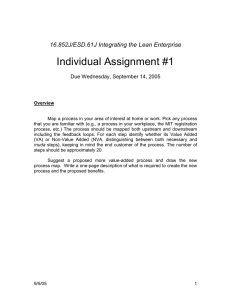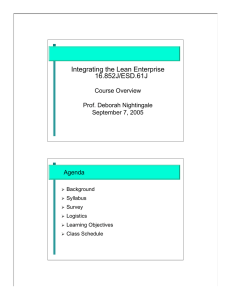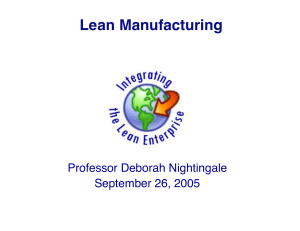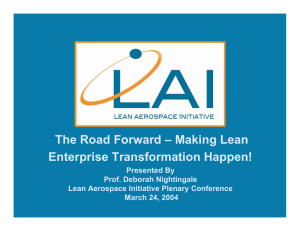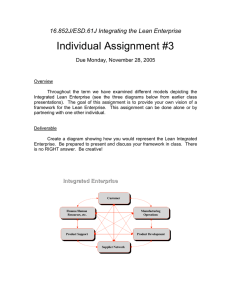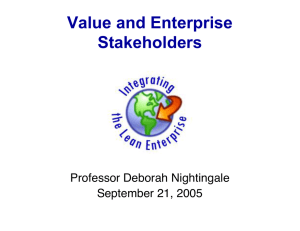Transformational Leadership Professor Deborah Nightingale November 2, 2005
advertisement
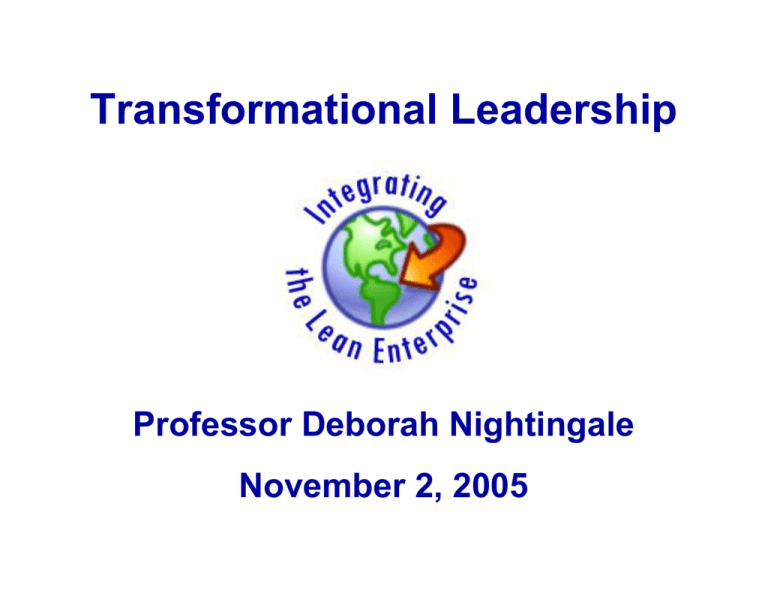
Transformational Leadership Professor Deborah Nightingale November 2, 2005 Management Vs. Leadership Management Management • Leadership Planning & budgeting • Organizing & staffing • Controlling & problem solving • Establishing direction • Aligning people • Motivating & inspiring • Produces a degree of predictability & order • Produces change, often to a dramatic degree • Has potential to consistently produce short term results expected by various stakeholders (e.g., for customers always being on time; for stockholders, being on budget) • Has potential to produce extremely useful change (e.g., new products that customers want, new approaches to labor relations that help make a firm more competitive Source: John P. Kotter, Leading Change, Harvard Business School Press ESD.61J / 16.852J: Integrating the Lean Enterprise © Deborah Nightingale, 2005 Massachusetts Institute of Technology Page 2 8 Steps to Transforming Your Organization 1 Establishing a Sense of Urgency 2 Forming a Powerful Guiding Coalition 3 Creating a Vision 4 Communicating the Vision 5 Empowering Others to Act on the Vision 6 Planning for and Creating Short-Term Wins 7 Consolidating Improvements and Producing Still More Change 8 Institutionalizing New Approaches Source: John P. Kotter, Leading Change, Harvard Business School Press ESD.61J / 16.852J: Integrating the Lean Enterprise © Deborah Nightingale, 2005 Massachusetts Institute of Technology Page 3 1 Establishing a Sense of Urgency • Examine market and competitive realities • Identify and discuss crises, potential crises, or major opportunities • Create the “burning platform” • 50% of companies fail at this stage • Underestimate difficulty in driving people out of comfort zone • Lack of patience - “get on with it” • Complacency Source: John P. Kotter, Leading Change, Harvard Business School Press ESD.61J / 16.852J: Integrating the Lean Enterprise © Deborah Nightingale, 2005 Massachusetts Institute of Technology Page 4 Sources of Complacency The absence of a major and visible crisis Too much happy talk from senior management Human nature, with its capacity for denial, especially if people are already busy or stressed Too many visible resources Complacency Low overall performance standards Organizational structures that focus employees on narrow functional goals A kill-the-messenger-ofbad-news, low-candor, low-confrontation culture A lack of sufficient performance feedback from external sources Internal measurement systems that focus on the wrong performance indexes Source: John P. Kotter, Leading Change, Harvard Business School Press ESD.61J / 16.852J: Integrating the Lean Enterprise © Deborah Nightingale, 2005 Massachusetts Institute of Technology Page 5 Ways to Raise the Urgency Level • Create a crisis by allowing a financial loss, exposing managers to major weaknesses vis-à-vis competitors, or allowing error to blow up instead of being corrected at the last minute • Eliminate obvious examples of excess (e.g., company-owned country club facilities, a large air force, gourmet executive dining rooms • Set revenue, income, productivity, customer satisfaction, and cycletime targets so high that they can’t be reached by conducting business as usual • Stop measuring subunit performance based only on narrow functional goals. Insist that more people be held accountable for broader measures of business performance. Source: John P. Kotter, Leading Change, Harvard Business School Press ESD.61J / 16.852J: Integrating the Lean Enterprise © Deborah Nightingale, 2005 Massachusetts Institute of Technology Page 6 Ways to Raise the Urgency Level (cont.) • Send more data about customer satisfaction & financial performance to more employees, especially information that demonstrates weaknesses vis-à-vis the competition. • Insist that people talk regularly to unsatisfied customers, unhappy suppliers, and disgruntled shareholders. • Use consultants & other means to force more relevant data and honest discussion into management meetings. • Put more honest discussions of the firm’s problems in company newspapers & senior management speeches. Stop senior management “happy talk.” • Bombard people with information on future opportunities, on the wonderful rewards for capitalizing on those opportunities & on the organization’s current inability to pursue those opportunities. Source: John P. Kotter, Leading Change, Harvard Business School Press ESD.61J / 16.852J: Integrating the Lean Enterprise © Deborah Nightingale, 2005 Massachusetts Institute of Technology Page 7 2 Forming a Powerful Guiding Coalition • Assemble a group with enough power to lead the change effort • Encourage the group to work together as a team • Grow team to 20 to 50 range in large companies • Failures due to: • No history of teamwork at top • Undervalue importance • Select wrong leadership (staff vs. line) Source: John P. Kotter, Leading Change, Harvard Business School Press ESD.61J / 16.852J: Integrating the Lean Enterprise © Deborah Nightingale, 2005 Massachusetts Institute of Technology Page 8 Building a Coalition That Can Make Change Happen Find the Right People People • With strong position power, broad expertise & high credibility • With leadership & management skills, especially the former Create Trust • Through carefully planned off-site events • With lots of talk and joint activities Develop a Common Goal • Sensible to the head • Appealing to the heart Source: John P. Kotter, Leading Change, Harvard Business School Press ESD.61J / 16.852J: Integrating the Lean Enterprise © Deborah Nightingale, 2005 Massachusetts Institute of Technology Page 9 3 Creating a Vision • Create a vision to help direct the change effort • Develop strategies for achieving that vision • A vision says something that clarifies the direction in which an organization needs to move • The vision “magnetically” pulls the organization “The soul never thinks without a picture.” -- Aristotle Aristotle Source: John P. Kotter, Leading Change, Harvard Business School Press ESD.61J / 16.852J: Integrating the Lean Enterprise © Deborah Nightingale, 2005 Massachusetts Institute of Technology Page 10 Characteristics of an Effective Vision Imaginable - conveys a picture of what the future will look like Desirable - appeals to the long-term interests of employees, customers, stockholders, and others who have a stake in the enterprise Feasible - comprises realistic, attainable goals Focused - is clear enough to provide guidance in decision making Flexible - is general enough to allow individual initiative and alternative responses in light of changing conditions Communicable - is easy to communicate; can be successfully explained within five minutes Source: John P. Kotter, Leading Change, Harvard Business School Press ESD.61J / 16.852J: Integrating the Lean Enterprise © Deborah Nightingale, 2005 Massachusetts Institute of Technology Page 11 Features of a Vision • It will be cohesive, providing a common thread through business mission and subsequent strategies • It will be specific enough to provide direction yet general enough to remain relevant despite fluctuations in the short term • It will be inspiring, aiming at “excellence” as defined by the organization • It will describe the core values strongly held by the organization • It will provide a yardstick by which to judge the future performance of the organization Source: Stephen Connack (1991) ESD.61J / 16.852J: Integrating the Lean Enterprise © Deborah Nightingale, 2005 Massachusetts Institute of Technology Page 12 You must translate the vision from words to pictures with a vivid description of what it will be like to achieve your goal. Source: James C. Collins, Building Your Company’s Vision, Harvard Business Review, September - October 1996 ESD.61J / 16.852J: Integrating the Lean Enterprise © Deborah Nightingale, 2005 Massachusetts Institute of Technology Page 13 Features of a Vision Envisioned Future should contain Big, Hairy, Audacious Goals • Is a powerful way to stimulate progress • Is clear and compelling • serves as a unifying focal point of effort • Acts as a catalyst for team spirit • Has a clear finish line • Should not be a sure bet - it will have perhaps only a 50% to 70% probability of success - but the organization must believe that it can reach the goal anyway Source: Stephen Connack (1991) ESD.61J / 16.852J: Integrating the Lean Enterprise © Deborah Nightingale, 2005 Massachusetts Institute of Technology Page 14 What’s needed is such a big commitment that when people see what the goal will take, there’s an almost audible gulp. Source: James C. Collins, Building Your Company’s Vision, Harvard Business Review, September - October 1996 ESD.61J / 16.852J: Integrating the Lean Enterprise © Deborah Nightingale, 2005 Massachusetts Institute of Technology Page 15 BHAG Be America’s Best! We will be the Benchmark Provider of Logistics Capability Sustaining our Nation’s Warfighter. -Support System Availability at 90% or better -Support Readiness at 100% -50% Reduction in Flow Time -25%Reduction in Cost ESD.61J / 16.852J: Integrating the Lean Enterprise © Deborah Nightingale, 2005 Massachusetts Institute of Technology Page 16 - Fully trained Fullywho trained employees reflect employees who a culture of reflect a culture of continuous process continuous process improvement improvement Ogden ALC’s Strategic Visioning 10 3-5 WarFighter We are committed To supporting our nation’s Warfighters and have Made great strides in our efforts to continue to improve. We recognize That we do not always meet warfighter expectations for systems availability And contingency support. We do not anticipate demand sufficiently. We Are not responsive to the dynamics of customer needs.We do not always meet our flow commitmentsGenerally, the quality of our products is acceptableBut our costs are not predictable. Effective communication withThe warfighter is inconsistent. We understand and exceed warfighter expectations for systems availability and contingency support. We have achieved this by anticipating requirements, reducing average flowtime 25% and cost 10% and improving quality. a We are Valued members of the community.We strive to be Responsive, fair, and equitable to our stakeholders. At times, our Stakeholders perceive us as inflexible and difficult to deal with. Effective Communication with the stakeholder is inconsistent. The collaborative Relationship between us and our partners/suppliers Is immature. Stakeholder feedback tells us we have an agile, expeditionary mindset. We support and communicate with all stakeholders and advocate consistent With mission availability needs. We are aligned with leadership and are accountable for all missions. We treat partners and suppliers fairly and equitably. We are easy to deal with, and we are valued members of the community. a Stakeholders a Resources Internal Business Processes Learning & growth We are incentivised To consume all resources as soon as possible. We Expand some resources without prioritizing programs/projects against mission accomplishment. We are compelled to accept workload Without the necessary resources. We have not successfully demonstrated a strategy to reinvest savings in facilities. Equipment and people. We do not fully articulate the consequences of failing to secure the Resources necessary to meet customer needs. OO-ALC plans for, articulates requirements and competes effectively for resources to meet customer needs. We have prioritized, reduced by 10% the need for resources, and reinvested the savings to provide facilities, equipment and people to exceed warfighter expectations. a Our Legacy and information systems, Policies, financial rules, and skill limitations drive inefficiency And inflexibility in our business processes. Our metrics don’t always Align with our strategic goals. Relevant information is not available To make real-time business decisions. We have effective and efficient Business Processes that enable tus to anticipate demand Then deliver products at 10% less cost, improved quality, and in 25 % less time. Our customer focused processes support continuous Improvement, open communication, and flexibility. We are committed To continuous learning and growth for all employees And are working on comprehensive career development programs. Currently career development programs are missing for some job series and others fall short. A comprehensive training program does not exist across The center and training is severely under funded. Not all employees Understand their role in accomplishing the enterpriseGoals and do not feel empowered To change their ownProcesses. We have Created an enduring culture of training, education. And mentoring in the ALC. Through our comprehensive Development programs, everyone understands their role in the enterprise, feels empowered, and participates as change agents. Sought after Sought advisorafter advisor for sustainment for sustainment of developing of developing weapon systems weapon systems Full and Open Full and Open communication communication Be America’s Best! throughout the throughout Enterprise the Enterprise We will be the Benchmark provider of logistics capability sustaining our Nation’s war fighters. • support system availability at 90% or better • Support Readiness at 100% • 50% reduction in flow time Others write Others write about “How about “How We Did It” We Did It” We are the We and are the Best it Best and it is obvious is obvious • 25% cost reduction Excellence: Integrity: Trust and honesty are the foundation of all individual and organizational efforts. We always do the right thing and are accountable for our actions, even when no one is watching. Service Before Self: A selfless commitment of patriotic service by every member of the enterprise to satisfy the needs of our Customers. ESD.61J / 16.852J: Integrating the Lean Enterprise Individuals and organizations striving, with pride and commitment, to be world class. To Sustain and Improve the war fighter's capability to defend our Freedom © Deborah Nightingale, 2005 Massachusetts Institute of Technology OO-ALC is the model OO-ALC is the in model organization organization government &in government & industry and a leader industry and a leader ofoflean ininthe leansector thepublic public sector Page 17 Creating an Effective Vision First Draft • The process often starts with an initial statement from a single individual, reflecting both his or her dreams and real marketplace needs. Role of the guiding coalition • The first draft is always modeled over time by the guiding coalition or an even larger group of people. Importance of teamwork • The group process never works well without a minimum of effective teamwork. Role of the head and the heart • Both analytical thinking and a lot of dreaming are essential throughout the activity. Source: John P. Kotter, Leading Change, Harvard Business School Press ESD.61J / 16.852J: Integrating the Lean Enterprise © Deborah Nightingale, 2005 Massachusetts Institute of Technology Page 18 Creating an Effective Vision (cont.) Messiness of the process • Vision creation is usually a process of two steps forward and one back, movement to the left and then to the right. Time frame • Vision is never created in a single meeting. The activity takes months, sometimes years. End product • The process results in a direction for the future that is desirable, feasible, focused, flexible, and is conveyable in five minutes or less. Source: John P. Kotter, Leading Change, Harvard Business School Press ESD.61J / 16.852J: Integrating the Lean Enterprise © Deborah Nightingale, 2005 Massachusetts Institute of Technology Page 19 The Relationship of Vision, Strategies, Plans and Budgets Vision A sensible and appealing picture of the future Leadership Creates Strategies A logic for how the vision can be achieved Plans Specific steps and timetables to implement the strategies Budgets Plans converted into financial projections and goals Management Creates Source: John P. Kotter, Leading Change, Harvard Business School Press ESD.61J / 16.852J: Integrating the Lean Enterprise © Deborah Nightingale, 2005 Massachusetts Institute of Technology Page 20 4 Communicating the Vision Key Elements in Effective Communication of Vision: • Simplicity • Metaphor, analogy, and example • Multiple forms • Repetition • Leadership by example • Explanation of seeming inconsistencies • Give-and-take Source: John P. Kotter, Leading Change, Harvard Business School Press ESD.61J / 16.852J: Integrating the Lean Enterprise © Deborah Nightingale, 2005 Massachusetts Institute of Technology Page 21 5 Empowering Others to Act on the Vision • Get rid of obstacles to change • Change systems or structures that seriously undermine the vision • Encourage risk taking and nontraditional ideas, activities, and actions • Make tough decisions in removing people who do not ascribe to vision Source: John P. Kotter, Leading Change, Harvard Business School Press ESD.61J / 16.852J: Integrating the Lean Enterprise © Deborah Nightingale, 2005 Massachusetts Institute of Technology Page 22 Barriers to Empowerment Formal structures make it difficult to act. Bosses discourage actions aimed at implementing the new vision. Employees understand the vision & want to make it a reality, but are are boxed in. A lack of needed skills undermines action. Personnel & information systems make it difficult to act. Source: John P. Kotter, Leading Change, Harvard Business School Press ESD.61J / 16.852J: Integrating the Lean Enterprise © Deborah Nightingale, 2005 Massachusetts Institute of Technology Page 23 Empowering People to Effect Change • Communicate a sensible vision to employees • Make structures compatible with the vision • Provide the training employees need • Align information & personnel systems to the vision • Confront supervisors who undercut needed change Source: John P. Kotter, Leading Change, Harvard Business School Press ESD.61J / 16.852J: Integrating the Lean Enterprise © Deborah Nightingale, 2005 Massachusetts Institute of Technology Page 24 6 Planning for & Creating Short Term Wins • Create and plan for visible performance improvements • Recognize and reward employees involved in the improvements Source: John P. Kotter, Leading Change, Harvard Business School Press ESD.61J / 16.852J: Integrating the Lean Enterprise © Deborah Nightingale, 2005 Massachusetts Institute of Technology Page 25 The Role of Short-Term Wins • Provide evidence that sacrifices are worth it: Wins greatly help justify the short-term costs involved. • Reward change agents with a pat on the back: After a lot of hard work, positive feedback builds morale and motivation • Help fine-tune vision and strategies: Short-term wins give the guiding coalition concrete data on the viability of their ideas. • Undermine cynics and self-serving resisters: Clear improvements in performance make it difficult for people to block needed change. • Keep bosses on board: Provides those higher in the hierarchy with evidence that transformation is on track. • Build momentum: Turns neutrals into supporters, reluctant supporters into active helpers, etc. Source: John P. Kotter, Leading Change, Harvard Business School Press ESD.61J / 16.852J: Integrating the Lean Enterprise © Deborah Nightingale, 2005 Massachusetts Institute of Technology Page 26 The Relationship of Leadership, Management, Short Term Results & Successful Transformation Leadership ++ All highly successful transformation efforts combine good leadership with good management. Transformation efforts can be successful for a while, but often fail after short term results become erratic. + Short term results are possible, especially through cost cutting or mergers & acquisitions. But real transformation programs have trouble getting started & major, long term change is rarely achieved. Transformation efforts go nowhere. 0 ++ + Management Source: John P. Kotter, Leading Change, Harvard Business School Press ESD.61J / 16.852J: Integrating the Lean Enterprise © Deborah Nightingale, 2005 Massachusetts Institute of Technology Page 27 7 Consolidating Improvements & Producing Still More Change • Use increased credibility to change systems, structures and policies that don’t fit the vision • Hire, promote & develop employees who can implement the vision • Reinvigorate the process with new projects, themes and change agents • Confront even bigger issues and problems Source: John P. Kotter, Leading Change, Harvard Business School Press ESD.61J / 16.852J: Integrating the Lean Enterprise © Deborah Nightingale, 2005 Massachusetts Institute of Technology Page 28 Degree of Change Increasing Amounts of Change Required for Successful Transformation 10 9 8 7 6 5 4 3 2 1 1 2 3 4 5 6 7 Years ESD.61J / 16.852J: Integrating the Lean Enterprise © Deborah Nightingale, 2005 Massachusetts Institute of Technology Page 29 What Stage 7 Looks Like in a Successful, Major Change Effort • More change, not less • More help • Leadership from senior management • Project management and leadership from below • Reduction of unnecessary interdependencies Source: John P. Kotter, Leading Change, Harvard Business School Press ESD.61J / 16.852J: Integrating the Lean Enterprise © Deborah Nightingale, 2005 Massachusetts Institute of Technology Page 30 8 Institutionalizing New Approaches • Articulate the connections between the new behaviors and corporate success • Develop the means to ensure leadership development and succession • Anchor change in a new culture Source: John P. Kotter, Leading Change, Harvard Business School Press ESD.61J / 16.852J: Integrating the Lean Enterprise © Deborah Nightingale, 2005 Massachusetts Institute of Technology Page 31 Anchoring Change in a Culture • Comes last, not first • Depends on results • Requires a lot of talk • May involve turnover • Makes decisions on succession crucial Source: John P. Kotter, Leading Change, Harvard Business School Press ESD.61J / 16.852J: Integrating the Lean Enterprise © Deborah Nightingale, 2005 Massachusetts Institute of Technology Page 32 th 20 and st 21 Century Organization Compared Structure 20th Century 21st Century • Bureaucratic • Non-bureaucratic, fewer rules & employees • Multi-leveled • Organized with the expectation that senior management will manage • Characterized by policies and procedures that create many complicated internal interdependencies • Limited to fewer levels • Organized with the expectation that management will lead, lower-level employees will manage • Characterized by policies and procedures that produce the minimal internal interdependence needed to serve customers Source: John P. Kotter, Leading Change, Harvard Business School Press ESD.61J / 16.852J: Integrating the Lean Enterprise © Deborah Nightingale, 2005 Massachusetts Institute of Technology Page 33 th 20 and st 21 Century Organization Compared Systems 20th Century 21st Century • Depend on few performance information systems • Distribute performance data to executives only • Offer management training & support systems to senior people only • Depend on many performance information systems, providing data on customers especially • Distribute performance data widely • Offer management training and support systems to many people Source: John P. Kotter, Leading Change, Harvard Business School Press ESD.61J / 16.852J: Integrating the Lean Enterprise © Deborah Nightingale, 2005 Massachusetts Institute of Technology Page 34 th 20 and st 21 Century Organization Compared Culture 20th Century 21st Century • Inwardly focused • Externally oriented • Centralized • Empowering • Slow to make decisions • Quick to make decisions • Political • Open and candid • Risk averse • More risk tolerant Source: John P. Kotter, Leading Change, Harvard Business School Press ESD.61J / 16.852J: Integrating the Lean Enterprise © Deborah Nightingale, 2005 Massachusetts Institute of Technology Page 35
